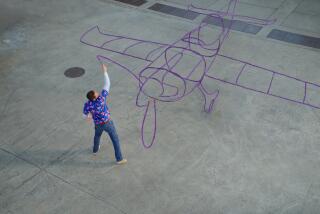New Laurel and Hardy Insights : Another Fine Mess of Facts You Can Get Into
Randy Skretvedt was 5 when he saw his first Laurel and Hardy movie on TV one Saturday morning in 1964.
“It was ‘Swiss Miss,’ and I just laughed and laughed and laughed,” Skretvedt recalled. “More so than liking them for their gags, it’s the characters and their relationship to each other that intrigued me. They really do say something quite profound about friendships and relationships. You just don’t get that with the Three Stooges.”
Now 28, the Buena Park resident has lost none of his childhood affection for the classic comedy duo, who are the subjects of his just-published book, “Laurel and Hardy: The Magic Behind the Movies” (Moonstone Press; $14.95). Consider:
- With the exception of two “missing” films, the 1982 Cal State Fullerton graduate has seen all 105 Laurel and Hardy movies, some of them as many as 50 times.
- He served eight years as the “grand sheik” of the Orange County chapter of the Sons of the Desert, the international Laurel and Hardy appreciation society, and he still supplies the films for the group’s monthly meetings in a Huntington Beach savings and loan.
- Over the years, he has collected enough Laurel and Hardy memorabilia to auction off two-thirds of his collection in 1985 and still have enough to completely fill his bedroom--everything from tacky Laurel and Hardy lamps, toys and statues to rare posters, photos and lobby cards.
But the most telling example of Skretvedt’s affection for Laurel and Hardy are the seven years he spent researching and writing his 462-page Laurel and Hardy tome, which is billed as “the definitive book on the world’s greatest comedy team.”
Filled with more than 275 rare photos and illustrations, the book gives an insightful look at the making of Laurel and Hardy’s screen comedies from the point of view of the actors and technicians who worked alongside “the boys,” as fans refer to their beloved Stan and Ollie.
“The idea of the book as much as possible was to get the day-to-day workings of the studio and what it was like be on the set making movies with Laurel and Hardy,” Skretvedt said. “They went about it in such an unorthodox way, I wanted to get as much detail as possible.”
Among the duo’s unorthodox film-making practices, Skretvedt said, was shooting scenes in the sequence in which they appear in the finished film, unlike the usual method of filming scenes out of order.
50% of Script Tossed Out
“The reason they did this is they would habitually throw out about 50% of the script: When they got to the set the props and sets themselves would suggest better gags than the stuff they had written, and they never knew how their ad-libbing would change the story,” Skretvedt said.
Laurel and Hardy also rarely rehearsed their scenes before the cameras rolled, he said. “They liked to capture the spontaneity of the first run-through and get that on film: They wanted that freshness.”
But perhaps the most unusual practice of all, Skretvedt said, “is that Stan . . . was really the man who ran the whole show on the set. The director was very much secondary in importance to Stan Laurel.”
Skretvedt, co-author of an unauthorized biography of Steve Martin in 1980, was praised recently in Publisher’s Weekly for his “revealing look” at Laurel and Hardy, and for providing “unusual insights into the complex art of creating comedy.”
Skretvedt said the book grew out of his involvement with the Sons of the Desert as a teen-ager in the mid-1970s.
He remembers being enthralled by occasional guest speakers who would show up at the meetings--people who had actually known and worked with Laurel and Hardy, such as actress Anita Garvin and former Hal Roach Studio musical director T. Marvin Hatley, who wrote Laurel and Hardy’s musical signature, “The Coo Coo Song.”
“They would tell these great stories, and nobody was doing anything to preserve it,” Skretvedt recalled in a recent interview. “Finally, I said, ‘Well, if nobody else is going to do it, I’ll do it.’ ”
He began tape-recording the meetings, and, by the time he entered Cal State Fullerton as a communications major in 1979, he had amassed a sizable library of tapes. He also had an idea for a book.
“I felt a real need to preserve the firsthand accounts of the people who worked with Laurel and Hardy, and that was my main drive to write the book,” he said.
“I just felt this was a real important part of film history that hadn’t been documented yet. There had been many people who interviewed Stan Laurel, but that’s just one aspect of the story, and it just seemed like this opportunity was waiting there for me, and nobody else was taking advantage of it.”
Hal Roach Interviewed
Over a period of three years, Skretvedt interviewed about 60 people, including the colorful studio boss Hal Roach, then 89, and now a still-vigorous 95.
“That was the biggest thrill, talking to these people,” he said, then recounted an interview with Australian comedian Clyde Cook, who told him, “I’m 88, but I can still do this,” and then proceeded to wrap his leg around his neck.
Skretvedt conducted his interviews none too soon: About a third of the people he had interviewed have since died, he said.
But the interviews were the easy part. The factual research into the daily life of Hal Roach Studios proved to be both challenging and time-consuming.
“If somebody wants to research MGM or 20th Century Fox, all the material is there,” Skretvedt said. “In the case of the Hal Roach Studio (which was demolished in 1963) everything has been scattered to the wind.”
Although private collectors have much of the material, Skretvedt said, a good portion of it is at the USC library, where he spent countless hours examining everything from studio payroll ledgers to production meeting notes.
He spent two summers holed up at the Motion Picture Academy library poring over every issue of the Hollywood Reporter, Daily Variety and other movie trade papers, looking for anything that pertained to Laurel and Hardy’s film productions made between 1926 and 1945.
While on the trail of Laurel and Hardy, he also met a movie memorabilia dealer in 1980 who was selling about 50 old Laurel and Hardy film scripts, none of which, to Skretvedt’s knowledge, had ever surfaced before. Getting a look at them was not easy, however.
Couldn’t Afford Scripts
The dealer wanted $35 per script. Skretvedt said he couldn’t afford to buy them but needed to see them for his book. The dealer finally let him look at the scripts under one condition--he could not photocopy them. So, for several Saturdays in a row, Skretvedt sat in the man’s store in Hollywood, dictating the scripts into his tape recorder.
The scripts proved to be a comedy gold mine, yielding numerous Laurel and Hardy routines that had been cut from the final movies.
Beyond “resurrecting” the long-lost comedy routines, Skretvedt views his greatest accomplishment simply as having “preserved all the wonderful stories of the people who worked on the set of Laurel and Hardy.”
But Skretvedt--who once paid $2,200 for a collection of Oliver Hardy’s personal photographs and papers and still lives in his parents’ home in Buena Park, where even the curtains on his bedroom window have Laurel and Hardy imprinted on them--insists that his life doesn’t revolve around the famous duo.
“I don’t consider myself a fanatic about them,” he said. “I’ve met people so far gone--be it Laurel and Hardy, ‘Star Trek’ or the Beatles--that they have lost all sense of perspective, and that is their whole world. I don’t think I’m that way. There’s more to life than old two-reelers from the ‘30s.”
Music from the 1920s and 1930s, for example. Skretvedt has developed what he calls his “big mania” for the period music into a Sunday afternoon radio show, “Forward into the Past,” for which he has been host for the past five years on Pomona College’s radio station, KSPC-FM (88.7).
“My ‘nom de radio’ is Randy Brian,” he said with a laugh, “because nobody can understand ‘Skretvedt’ over the air.”
Still, 23 years after he saw his first Laurel and Hardy movie, his admiration for the comedy team is as strong as ever. Writing the book, he said, has only deepened his appreciation of the immortal Stan and Ollie.
“Even though I never met Laurel and Hardy . . . I feel as though I knew them because I’ve gotten to meet so many of their friends and contemporaries,” Skretvedt said. “I have a vivid picture in my mind of what it was like to work with them.”
More to Read
Sign up for our Book Club newsletter
Get the latest news, events and more from the Los Angeles Times Book Club, and help us get L.A. reading and talking.
You may occasionally receive promotional content from the Los Angeles Times.






